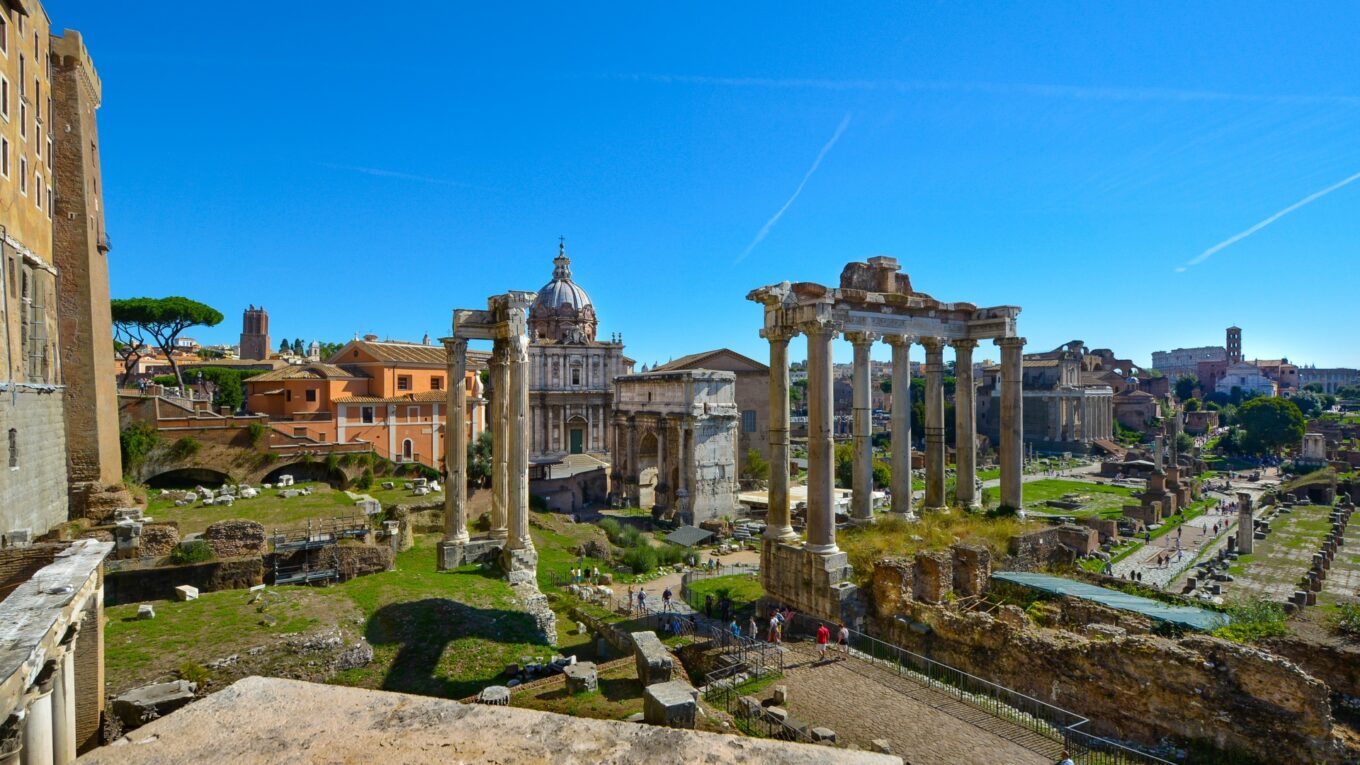Top 15 Ancient Roman Triumphal Arches
The Ancient Romans accomplished so much throughout the life of their incredible empire, and of course, the Romans were always eager to build monuments commemorating their accomplishments. They built triumphal arches throughout every Roman Province as a way to embellish the achievements of the Roman Emperors and acknowledge new territorial gains. Rome itself contains a massive concentration of these Triumphal Arches, such as the Arch of Titus and the Arch of Constantine, but the rest of the empire also had its fair share of monuments. Today, dozens of examples of Roman Triumphal Arches can be found throughout Europe and the Mediterranean, and this article will showcase some of the most impressive examples that survive from the time of the Ancient Roman Empire.
Who were the Romans, and why did they build Triumphal Arches?
At its peak, the Ancient Roman Empire spread from the British Isles in the northwest all the way to modern-day Egypt and Iraq in the southeast. The Romans were able to expand their empire through many different military conquests. Often, when Roman Emperors won great victories, they would build triumphant arches as a way to commemorate their achievements. For instance, the Arch of Septimius Severus, located in the Roman Forum, was built in honor of Severus’s victories over the Parthian Empire, a rival state located along Rome’s Eastern border.

What are the top Roman Triumphal Arches?
1. Arch of Constantine – Rome, Lazio, Italy

The Roman Emperor Constantine, who is often referred to as “Constantine the Great,” is regarded as one of the most successful rulers during a time when Rome was in a period of decline. Constantine is also famous for converting to Christianity after winning a decisive victory in battle over one of his rivals. Today, the Arch of Constantine stands right next to the Roman Colosseum. The detailed carvings throughout the arch show different depictions of battle scenes and Emperor Constantine himself. Along with several other Triumphal Arches, the Arch of Constantine is one of many commemorative monuments built in the Roman Capital.
2. Arch of Hadrian – Jerash, Jerash Govenorate, Jordan
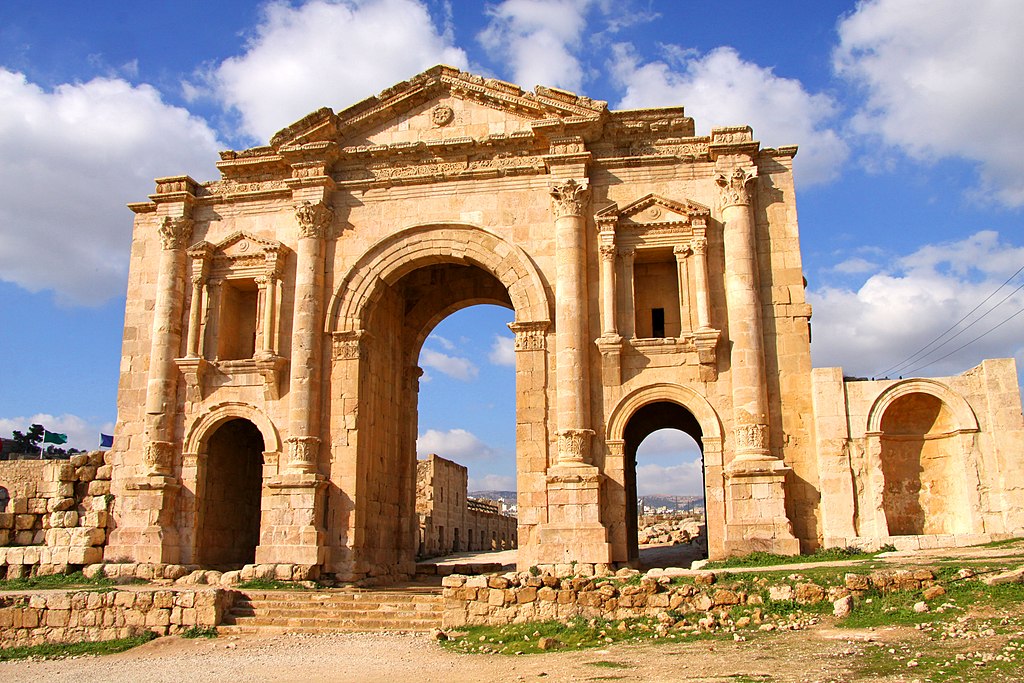
The Roman Emperor Hadrian commissioned the construction of a massive triumphal arch in the city of Gerasa in 130 CE. He traveled to that part of the empire during his reign, and the arch was a way to commemorate his visit. Hadrian, who ruled from 117 to 138 CE, was one of Rome’s greatest emperors. He is known for strengthening Rome’s borders by building Hadrian’s Wall in northern England, and he also built dozens of monuments throughout the empire, including three different triumphal arches.
3. Arch of Trajan – Ancona, Marche, Italy

Ancona, a city located on the Adriatic Coast of the Italian Peninsula, contains one of Italy’s most impressive Triumphal Arches. The Arch of Trajan was built in 115 CE and is completely decorated with white marble. The front showcases four columns topped with Corinthian Capitals, which is a typical feature in Roman Triumphal Arches. The staircase that leads up to the monument, however, is a unique element in this particular arch. The arch was built along the water’s edge so that anyone sailing through the port of Ancona could see it.
4. Arch of Septimius Severus – Rome, Lazio, Italy
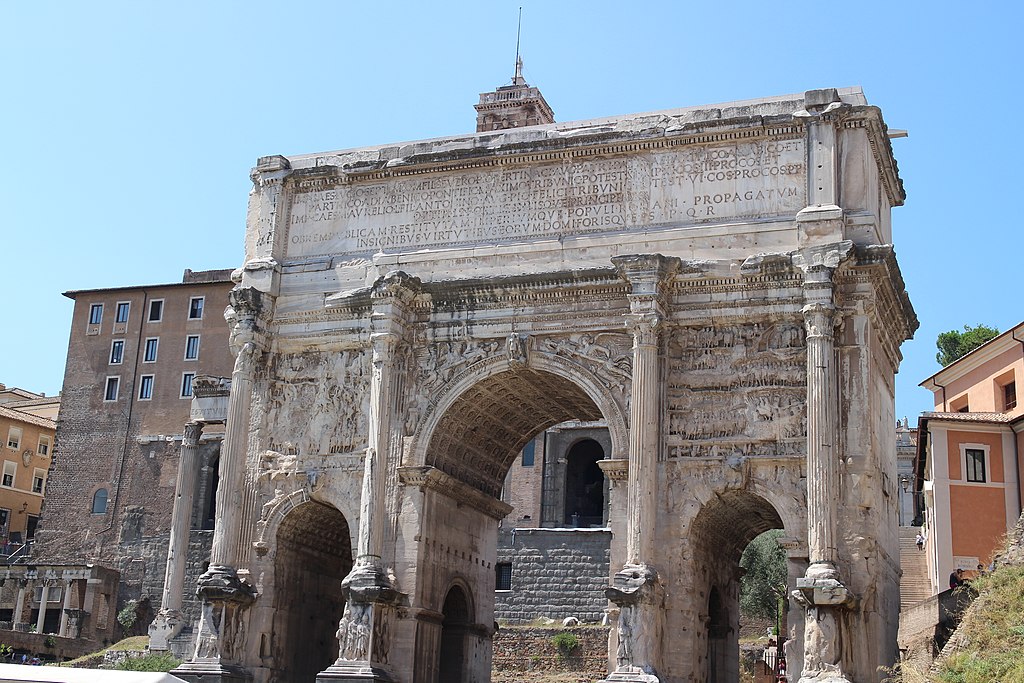
One of several notable arches within the capital city of Rome, the Arch of Septimius Severus was completed in 203 CE. The arch was to commemorate several victories that the Romans had over the Parthian Empire. The Parthians were a rival state that ruled much of modern-day Iran. The Arch of Septimius Severus is famous because of its prominent location within the Roman Forum. Although the stone of the arch is extremely eroded, you can still see some of the intricate details, such as the coffered ceiling within the archways.
5. Arch of Titus – Rome, Lazio, Italy

The Arch of Titus is one of the oldest Triumphal Arches in the city of Rome. The arch was built in 81 CE. by the emperor Domitian. Domitian wanted to commemorate his brother Titus, and his arch set the precedent for many others that came later. The Arch of Titus sits along the Via Sacra, or the Sacred Way. This was one of the main streets within the city, and many processions paraded down the Via Sacra to commemorate important victories and religious holidays.

The Eastern Roman Empire, also known as the Byzantine Empire would live on long after the fall of the Western Roman Empire. Read our article, “Top 25 Examples of Byzantine Architecture“ to learn about the architecture of the Byzantines!
6. Arco dei Gavi – Verona, Veneto, Italy

Verona, a city in northern Italy’s Veneto Region, is famous for its plethora of Roman Architecture. While the Ancient Roman Amphitheater of Verona might be the city’s most famous site from antiquity, the Arco de Gavi also shows how important Verona was back in ancient times. The arch was built during the 1st century CE, and it was paid for by a noble family that lived in that part of Italy. The arch was built along a major road connecting Verona with other Italian cities such as Cremona and Genoa.
7. Arch of Septimius Severus – Leptis Magna, Khoms, Libya
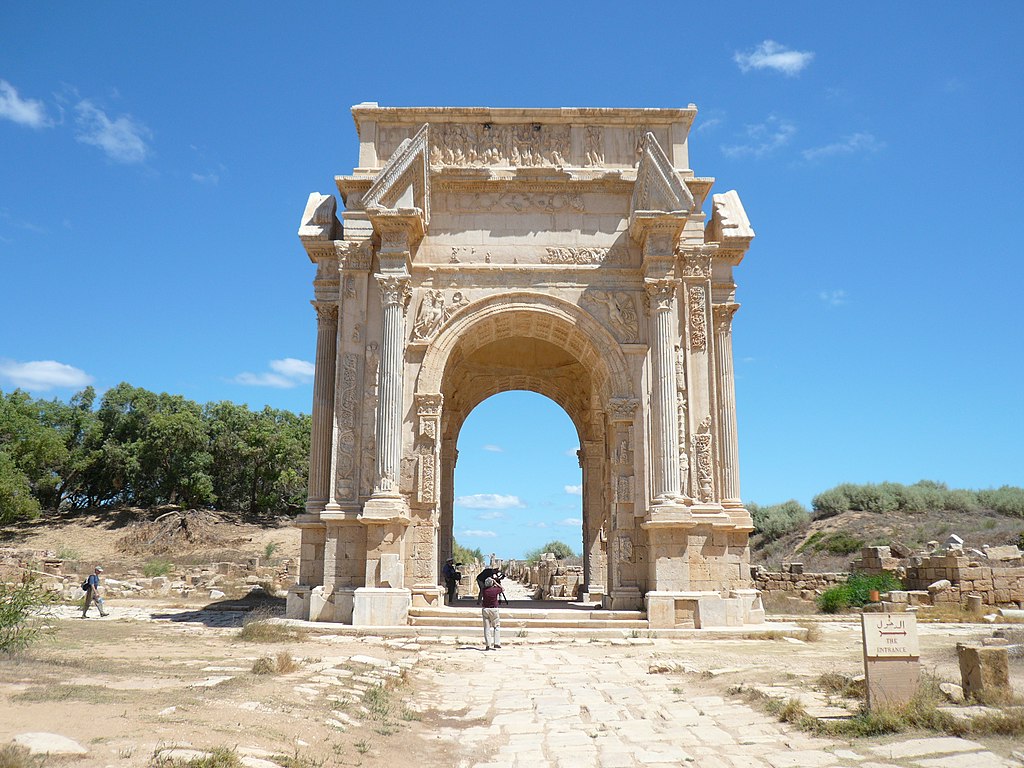
The Arch of Septimius Severus was commissioned by the emperor himself to commemorate his recent victories over the Parthian Empire. He built it along the main road in Leptis Magna, one of the largest cities in Rome’s North African territory. One characteristic that sets this Triumphal Arch apart from many others on this list is the fact that it’s symmetrical about both axes. While most arches had a distinct front and back, the Arch of Septimius Severus at Leptis Magna has a square plan, so all four elevations are nearly identical. Pedestrians can cross under the arch from both the north/south road and the east/west road.
8. Hadrian’s Gate – Antalya, Mediterranean Region, Turkey

Antalya is the fifth largest city in modern-day Turkey, and historically, it has been one of the largest ports on the Mediterranean coast of Anatolia. The city was controlled by the Ottoman Empire for centuries, and you can find countless examples of Ottoman Architecture throughout its historic center. Hadrian’s Gate served a dual purpose as a Triumphal Arch and an entrance through the city’s fortified wall. Today the three main arches remain remarkably well preserved, and visitors are welcome to walk beneath the arches and pass through Hadrian’s Gate as they enter the historic center of Antalya.
9. Arch of Trajan – Benevento, Campania, Italy
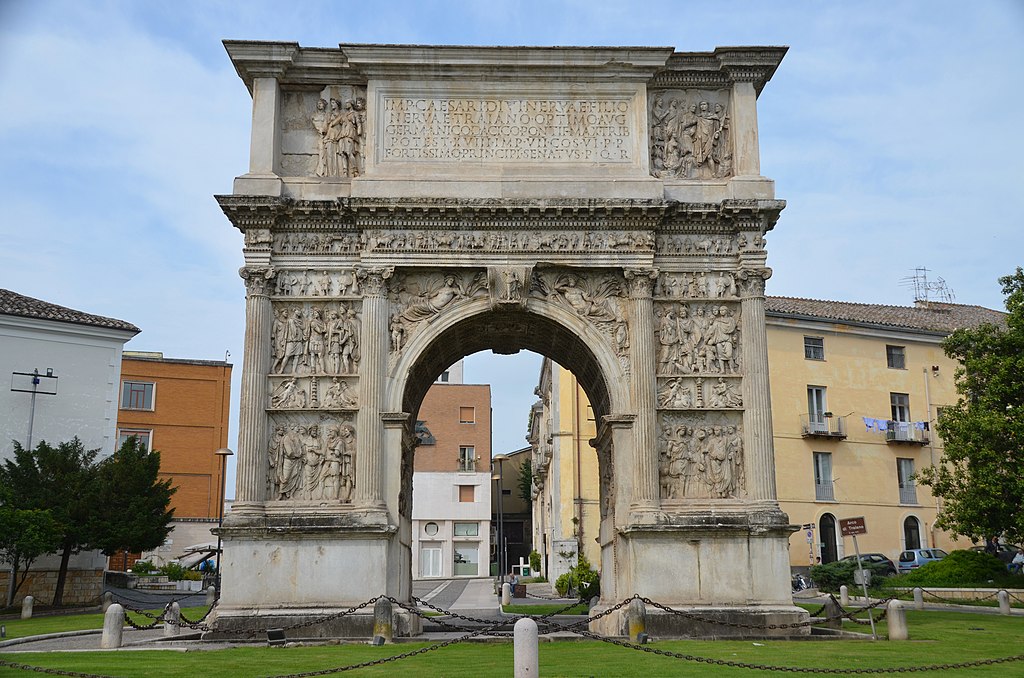
Trajan was arguably Rome’s greatest emperor. He ruled at a high point for the empire, and Trajan himself commanded many conquests throughout the Caucasus, Eastern Europe, and Mesopotamia. The arch of Trajan was erected in the city of Benevento along the Appian Way, or the Via Appia, which connected Rome with several southern Italian cities such as Taranto and Brindisi. Construction began in 114 CE, at the tail end of Trajan’s reign, and the arch contains some of the most detailed carvings of any Triumphal Arch on this list.
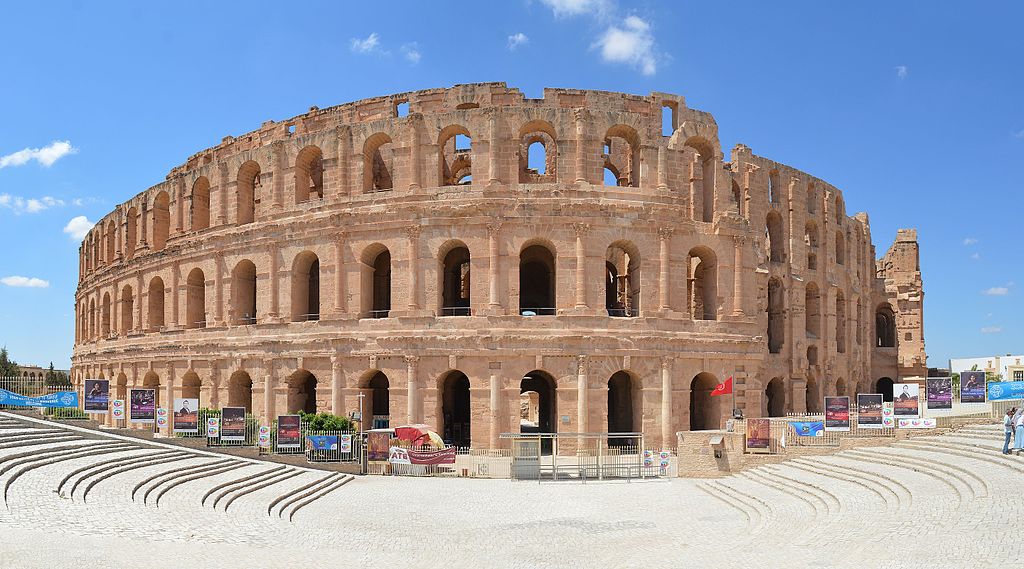
Read our article, “Top 20 Roman Amphitheaters” to learn more about the architecture of the Ancient Romans!
10. Arch of Janus – Rome, Lazio, Italy
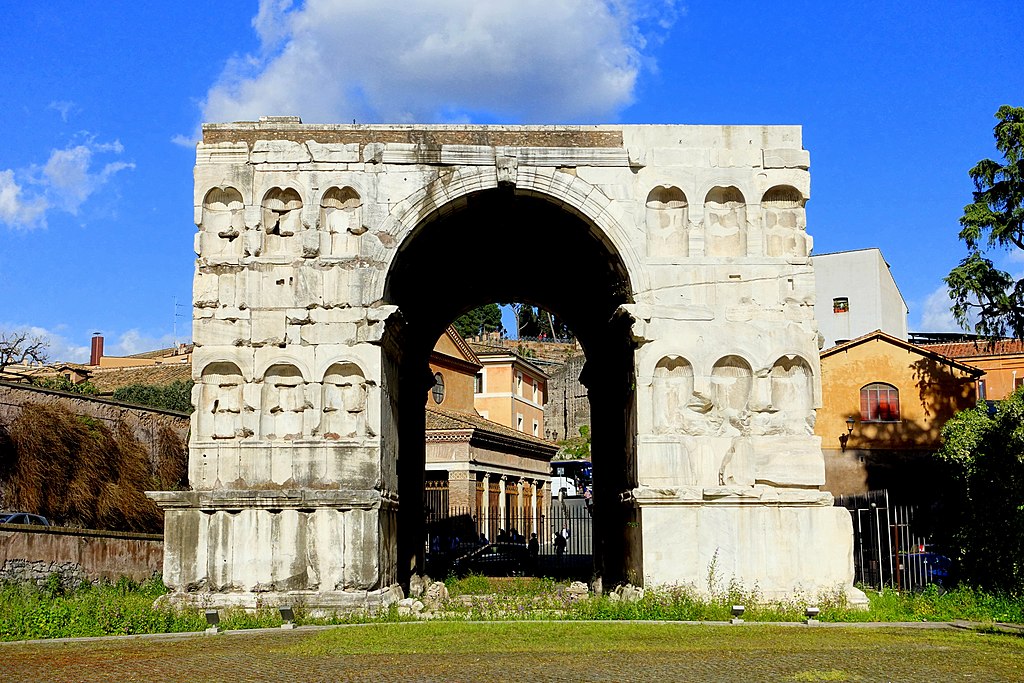
Unfortunately, the Arch of Janus is just a shadow of its former self. Back in ancient times, all of the masonry was still intact, and the niches throughout the exterior were filled with marble statues depicting Roman Deities. The Arch of Janus was even converted into a small fortress during the Middle Ages, at which point it resembled a defensive tower rather than a Triumphal Arch. However, in the 19th century, the authorities in Rome remodeled it to closely resemble its original form.
11. Arch of Germanicus – Saintes, Nouvelle-Aquitaine, France
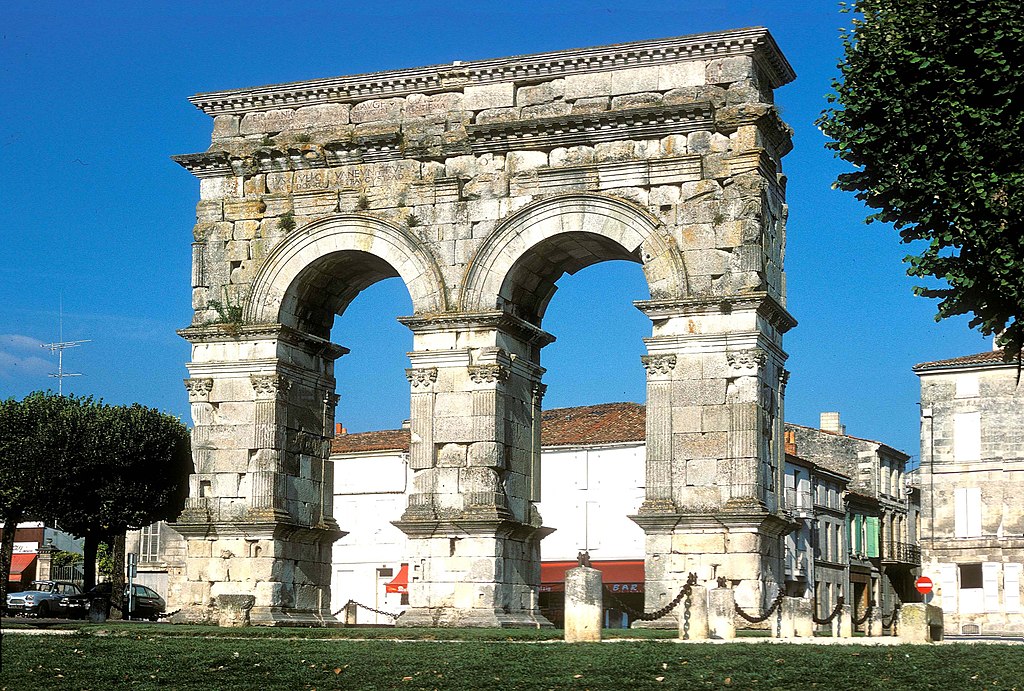
Saintes is a town in western France that was known as Mediolanum Santonum during Roman times. The Arch of Germanicus was built within the city, and it is dedicated to three people: the Roman Emperor Tiberius, his son Drusus, and his adoptive son Germanicus. It is believed that the arch was constructed in either 18 or 19 CE. Although the stonework isn’t as elaborate as later Roman Arches, you can still see many of the key elements of Ancient Roman Architecture. There are round arches, pilasters topped with Corinthian Capitals, and several different cornices at different levels of the monument.
12. Arch of Caracalla – Tébessa, Tébessa Province, Algeria
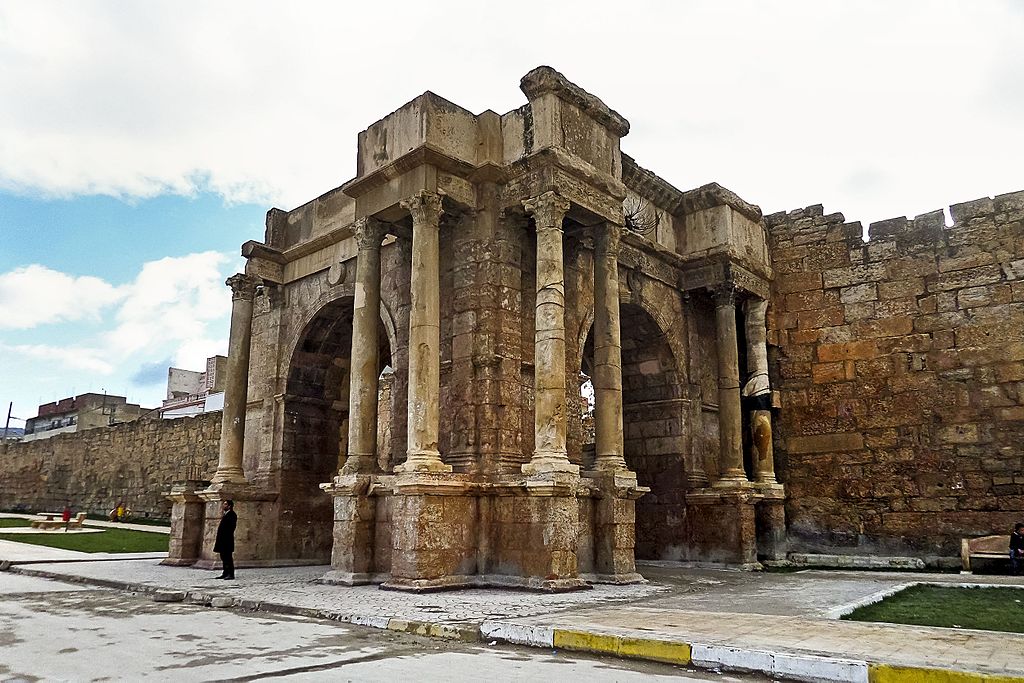
Completed in 214 CE, the Arch of Caracalla is a four-sided Roman Triumphal Arch located in the ancient city of Thebesta, now known as Tébessa, Algeria. The city remained in Roman hands until the year 435, when a Germanic tribe known as the Vandals took the entire province of North Africa from the crumbling Western Roman Empire. The Vandal Kingdom of North Africa would last for about a century when it was conquered by the Byzantine Empire, under the reign of Justinian the Great in 534 CE.
13. Arch of Orange – Orange, Provence, France
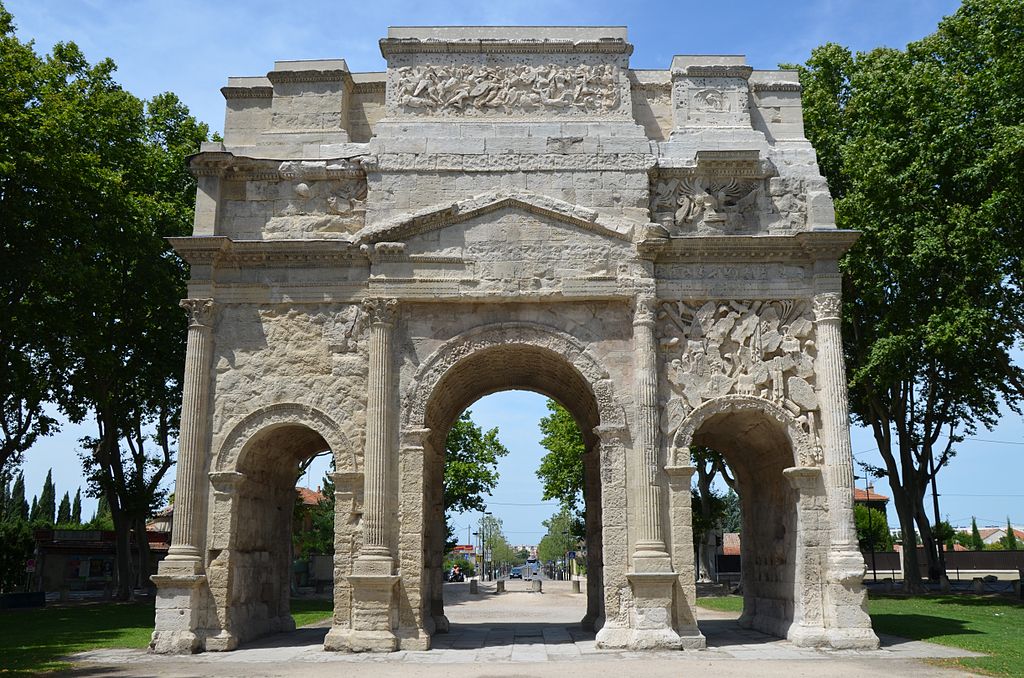
Orange is a beautiful town in the historic Provence Region of southern France. It is located a short drive away from other notable Roman sites such as the Pont du Gard. The city is well known for its many ancient buildings such as the famous Roman Theater of Orange. Although most people visit the town for the theater, the Triumphal Arch of Orange is another incredible site that is often overlooked. It is believed that this arch dates to the time of Roman Emperor Augustus, who ruled from 27 BCE to 14 CE. This makes it the oldest arch on this list at over 2000 years old.
14. Porte de Mars – Reims, Grand Est, France
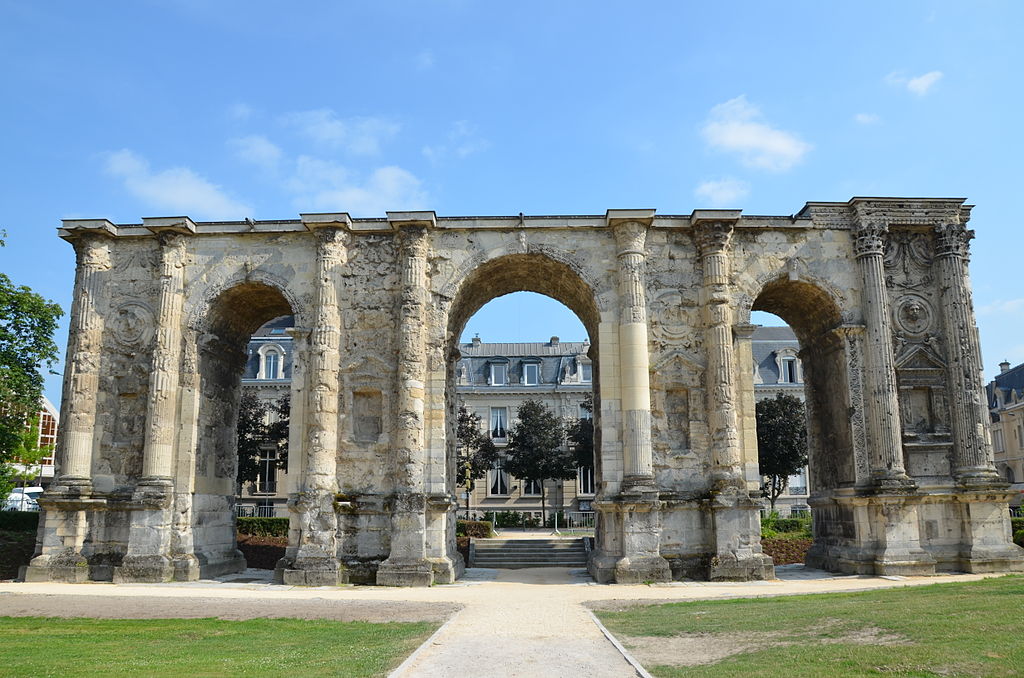
Reims, a city in France that is home to one of Europe’s greatest Gothic Cathedrals, was a flourishing city during the Roman Empire. At the time, the city was known as Durocortorum, and it was completely encircled by a defensive wall. The Porte de Mars served as one of the main entrances within this wall, but the majority of Reim’s fortifications have since been demolished. The Porte de Mars is the widest Roman Triumphal Arch ever constructed, with a length of over 100 feet (32 meters) from end to end.
15. Arch of Marcus Aurelius – Tripoli, Tripolitania, Libya
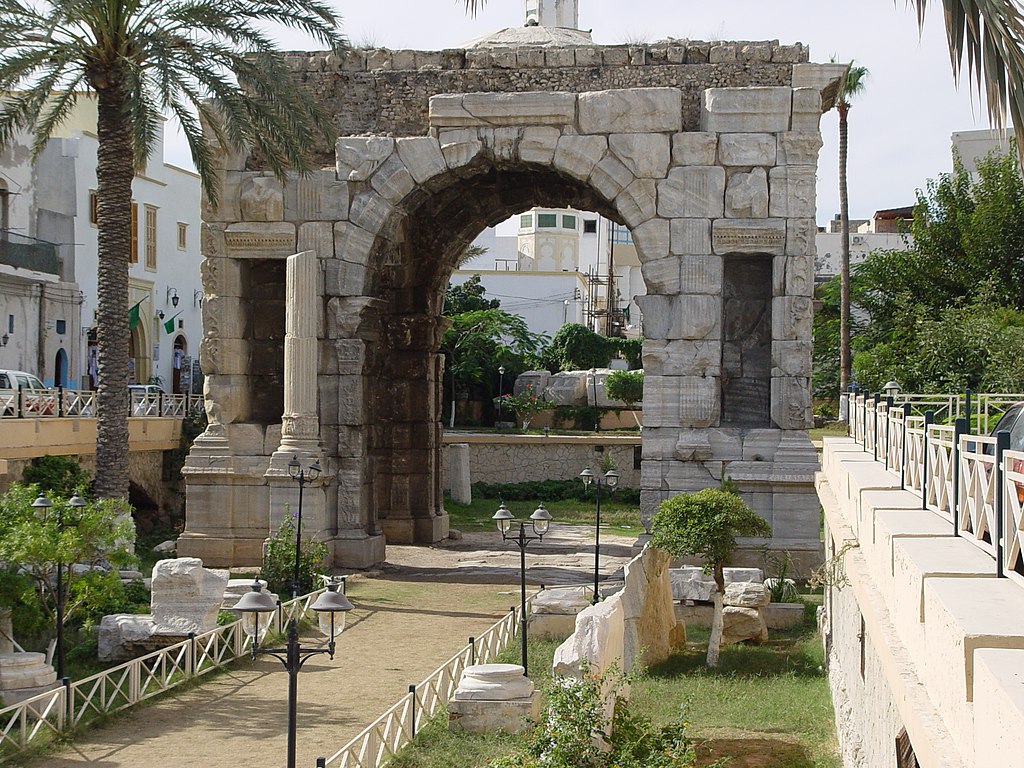
The Arch of Marcus Aurelius is another Roman Triumphal Arch built within Rome’s North African Territories. It was completed in 165 CE and was once completely covered in marble blocks, of which only about 70% remain. Although it wasn’t commissioned by Marcus Aurelius himself, the arch was built to commemorate him and his military victories. Over the centuries, a host of different rules have controlled this part of North Africa, including the Umayyad Caliphate, the Ottoman Empire, and the modern nation of Libya. The Arch of Marcus Aurelius has seen damage from both natural erosion and various conflicts that have occurred around Tripoli.

Read our article, “Top 20 Ancient Roman Aqueducts” to learn more about the architecture of the Ancient Romans!
Modern versions of Roman Triumphal Arches
Ancient Roman Architecture is one of the most influential building forms of all time. Countless elements from Roman Architecture were utilized in many of Europe’s great art movements, such as the Romanesque Style, the Renaissance Style, and the Neoclassical Style. Roman Triumphal Arches in particular have been reproduced throughout Europe, the United States, and beyond. Particularly in the 19th century, it was very in-fashion for cities to build triumphal arches as a way to commemorate their own achievements, in the same way the Romans did thousands of years ago.

The Washington Square Park Arch is a monument located in New York City in the United States. It was designed by Stanford White of the architectural firm McKim, Mead & White, one of America’s most productive design teams during the nation’s Gilded Age of the late 19th and early 20th centuries. The arch was completed in 1891, and it combines many elements of Classical Architecture along with distinct elements of Americana, such as the Bald Eagle located above the keystone of the arch. The Washington Square Arch was meant to commemorate the 100-year anniversary of the election of George Washington, the first president of the US, for whom Washington Square is named.

The Arc de Triomf is a monumental Triumphal Arch located in the Spanish city of Barcelona. It was built before the grand opening of the 1888 Barcelona Universal Exposition. Although the overall form is directly copied from earlier Roman Arches, that’s where the similarities stop. The Arc de Triomf is built using elements from Moorish, Mudejar, and Modernisme Architecture. While not built from marble like most other Triumphal Arches, the Arc de Triomf is built primarily with bricks which gives the monument a completely different feel than the others on this list.

The most famous reproduction of a Roman Triumphal Arch is, of course, the Arc de Triomphe in Paris, France. The Arc de Triomphe is truly massive, measuring 164 feet (50 m) high and 148 feet (45 m) wide. At the time it was completed, it was the largest Triumphal Arch in the world. The arch is dedicated to all of the soldiers who were lost in the battles of both the French Revolution and the Napoleonic Wars that followed. Construction took about 30 years and lasted from 1806 to 1836.
Influence of Roman Triumphal Arches
The Roman Empire was one of the largest empires to have ever existed, and Roman politics, culture, art, and architecture have all left lasting impressions on our modern world. Thanks to their dominance, the Romans had no shortage of great achievements. To commemorate all of their accomplishments, they built dozens of Triumphal Arches throughout Europe and the Mediterranean, which survive to this day. Today, we still find ourselves recreating the Roman monuments of the past, and Triumphal Arches, in particular, are still heavily utilized as a way to commemorate important people and events. Although the design of the Roman Triumphal Arch is simple, it’s also elegant and timeless, and it seems probable that we will still be making new versions of these arches well into the future.

- About the Author
- Rob Carney, the founder and lead writer for Architecture of Cities has been studying the history of architecture for over 15 years.
- He is an avid traveler and photographer, and he is passionate about buildings and building history.
- Rob has a B.S. and a Master’s degree in Architecture and has worked as an architect and engineer in the Boston area for 10 years.
Like Architecture of Cities? Sign up for our mailing list to get updates on our latest articles and other information related to Architectural History.


